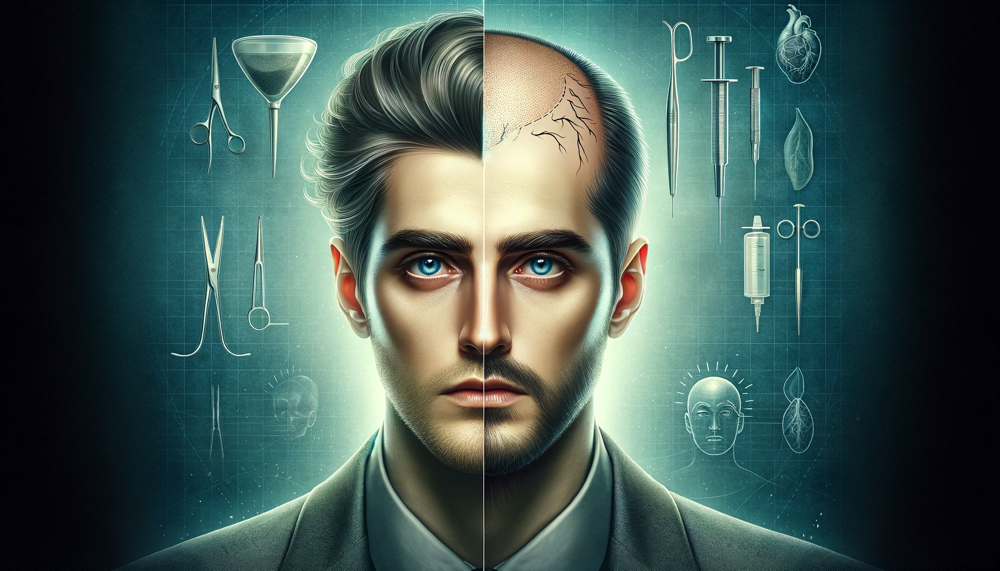Understanding Hair Transplants: What to Expect

Understanding Hair Transplants
Hair loss can be a distressing experience. ‘Understanding Hair Transplants’ offers a beacon of hope. This detailed guide provides essential insights into hair transplant procedures. It explains what patients can expect before, during, and after the process.
The Basics of Hair Transplants
What is a Hair Transplant?
A hair transplant involves moving hair to bald or thinning areas. It’s a proven solution for hair loss. Hair follicles are typically taken from the back of the head. They’re then transplanted to the affected areas.
Who Can Benefit?
Hair transplants are ideal for those experiencing baldness or thinning. Both men and women can benefit. The procedure is highly effective for most hair loss types. Your consultation with Dr. Mayer can clarify suitability.
The Role of Technology in Hair Transplants
Mayer Hair Restoration uses cutting-edge technology. As an ARTAS center of excellence, we use the ARTAS iX robotic system when it is appropriate for our patients. This ensures precision and enhances results. Our technology sets us apart as a leader in Hauppauge Long Island.
Understanding the Concept
A hair transplant is a surgical technique that moves hair follicles from one part of the body, known as the ‘donor site’, to a bald or balding part of the body known as the ‘recipient site’. It is primarily used to treat male pattern baldness. This procedure can also be used to restore eyelashes, eyebrows, beard hair, chest hair, and to fill in scars caused by accidents or surgery such as face-lifts and previous hair transplants.
Techniques in Hair Transplantation
There are two main techniques for harvesting hair follicles: Follicular Unit Transplantation (FUT) and Follicular Unit Extraction (FUE). In FUT, a strip of scalp is removed from the back of the head and is dissected into individual grafts. FUE involves the individual removal of each follicular unit directly from the scalp, without a strip of scalp being removed. Both methods have their advantages, and Dr. Mayer can advise on the best approach for each patient.
Suitability for the Procedure
Not everyone is a suitable candidate for a hair transplant. Therefore factors such as hair color, texture, and the extent of hair loss play a crucial role in the success of the procedure. During the consultation, Dr. Mayer assesses these factors to determine the most effective treatment plan.
Realistic Expectations
It’s important for patients to have realistic expectations. A hair transplant can significantly improve appearance but does not create new hair. It simply redistributes existing hair. Dr. Mayer discusses what results can realistically be achieved, based on individual conditions.
Duration and Recovery
The length of the transplant procedure depends on the extent of the work being done. Generally, it can take anywhere from four to eight hours. Recovery time is relatively short, with most patients returning to work within a week. Dr. Mayer provides detailed guidance on post-procedure care.
Long-Term Results
While a hair transplant is a permanent solution, it does not stop future hair loss. Some patients may require multiple sessions over time. Dr. Mayer creates a long-term plan to ensure sustained results, combining transplants with other treatments if necessary.
Preparing for a Hair Transplant
Initial Consultation: The First Step
The preparation for a hair transplant begins with an initial consultation. This is a critical step where Dr. Mayer assesses your hair loss and discusses your goals and expectations. During this meeting, Dr. Mayer will review your medical history, examine your scalp, and possibly take hair samples. This session helps in formulating a personalized treatment plan and setting realistic expectations for the procedure.
Physical Health Evaluation
Prior to the procedure, a thorough physical examination is essential. This might include blood tests and a review of your medical history. Ensuring that you are in good health is crucial for a successful transplant and minimizes the risk of complications.
Pre-Procedure Instructions
Patients receive detailed instructions to prepare for the surgery. This may include guidelines on diet, alcohol consumption, smoking, and medications. Certain medications like blood thinners and anti-inflammatory drugs might need to be paused as they can increase bleeding during the procedure. It’s vital to follow these instructions closely for optimal results.
Hair Care Before Surgery
Specific hair care instructions might be provided. This could involve using particular shampoos or avoiding hair treatments. Dr. Mayer advises patients on how best to care for their hair in the days leading up to the transplant.
Planning for the Day of the Procedure
Patients should plan for the day of the procedure. This includes arranging for transportation, as you might not be able to drive immediately after the surgery. It’s also advised to wear comfortable clothing and avoid any stressful activities.
Emotional Preparation
Undergoing a hair transplant can be emotionally taxing. Dr. Mayer and his team offer support and guidance to ensure patients feel confident and relaxed. Understanding the process, recovery time, and realistic outcomes can significantly ease any anxiety.
By diligently preparing for a hair transplant, patients can ensure a smoother procedure and recovery, paving the way for successful and satisfying results. Dr. Mayer and the team at Mayer Hair Restoration are committed to providing comprehensive guidance every step of the way.
The Hair Transplant Procedure
Step-by-Step Process
Once you understand the step-by-step process of a hair transplant it can alleviate anxieties and provide clarity for patients. The procedure typically involves the following stages:
- Preparation of the Donor Area: The area where hair follicles will be harvested is prepared. This usually involves trimming or shaving a small section of the scalp.
- Anesthesia: Local anesthesia is applied to the donor and recipient areas to minimize discomfort during the procedure.
- Harvesting Follicles: Depending on the technique (FUT or FUE), hair follicles are harvested from the donor area. In FUT, a strip of scalp is removed and then dissected into individual grafts. In FUE, individual follicles are extracted one at a time.
- Preparation of Grafts: Harvested follicles are prepared under a microscope to ensure they are intact and ready for transplantation.
- Creating Recipient Sites: Small incisions are made in the recipient area to place the grafts. This step is crucial for determining the density, angle, and direction of hair growth.
- Transplantation: The prepared grafts are carefully inserted into the incisions in the recipient area.
- Closing the Procedure: Once all grafts are placed, the scalp is cleaned, and, if necessary, stitches are used to close any incisions in the donor area.
Ensuring Comfort and Safety
The comfort and safety of the patient are paramount throughout the procedure. The team at Mayer Hair Restoration ensures that the environment is sterile, and the patient’s well-being is continuously monitored. Pain is typically minimal due to the local anesthesia, and patients often listen to music or watch movies during the procedure.
Duration of the Procedure
The duration of the hair transplant varies based on the number of grafts being transplanted. It can range from a few hours for a small session to a full day for larger sessions. Dr. Mayer provides a clear idea of the timeline during the consultation.
Immediate Post-Procedure Care
Immediately following the procedure, Dr. Mayer provides detailed instructions for care. This includes how to handle the treated area, medications for pain and swelling, and when to return for a follow-up examination.
Monitoring and Follow-Up
Regular follow-ups are scheduled to monitor the healing and success of the transplant. Dr. Mayer assesses the progress and provides guidance for ongoing care and any additional treatments if needed.
Short-Term Recovery
The short-term recovery period is generally straightforward. Patients can expect some redness, swelling, and mild discomfort, which usually subsides within a few days. Most patients return to normal activities within a week.
Post-Procedure Care and Results
Immediate Post-Procedure Care
Immediately after the hair transplant, it’s crucial to follow Dr. Mayer’s post-procedure instructions meticulously. These guidelines typically include:
- Wound Care: If there are any bandages, instructions on how and when to remove them will be provided. The treated area should be kept clean to prevent infection.
- Pain Management: Some discomfort is expected after the procedure. Over-the-counter pain relievers or prescribed medications can be used as directed.
- Swelling and Redness: Swelling of the forehead and around the eyes may occur. Sleeping with the head elevated for the first few nights can help reduce swelling.
- Shampooing and Hair Care: Specific instructions on how to wash your hair and care for the scalp will be given. Gentle washing with a prescribed shampoo often starts a few days after the procedure.
- Activity Restrictions: Vigorous physical activities should be avoided for a short period to ensure proper healing.
Short-Term Recovery and Healing
During the first few weeks, patients may notice scabbing and shedding of the transplanted hair. This is a normal part of the healing process. The scalp should be protected from direct sunlight and harsh environments.
Monitoring Hair Growth
Initial hair growth can be seen a few months after the procedure, but it’s important to have realistic expectations. The final results of the hair transplant are typically observed within 9 to 12 months.
Follow-Up Appointments
Regular follow-up appointments with Dr. Mayer are crucial. These visits allow monitoring of the healing process and assessment of the hair growth. Adjustments in care or additional treatments can be discussed during these appointments.
Long-Term Care and Maintenance
Long-term care may include using specific hair care products or medications to support hair growth and health. Dr. Mayer provides customized advice based on individual needs and results.
The Final Outcome
Patients can expect a noticeable improvement in their hair’s appearance. The success of the transplant depends on the quality of the donor hair, the skill of the surgeon, and adherence to post-procedure care. Dr. Mayer ensures that each patient achieves the best possible outcome.
Why Choose Mayer Hair Restoration
Expertise and Recognition
Dr. Mayer is a renowned expert in hair restoration. Our center is recognized for its excellence in Long Island. We are committed to providing the best solutions for hair loss.
Comprehensive Solutions
We offer solutions for both men and women. Our approach is tailored to individual needs. We utilize the latest technology for optimal results.
Taking the Next Step
Understanding hair transplants is the first step towards regaining your confidence. Dr. Mayer, with his expertise, can guide you through this transformative journey. At Mayer Hair Restoration, we blend technology with care to offer effective solutions. We invite you to sign up for a hair consultation. Discover how we can help you achieve your hair restoration goals.




